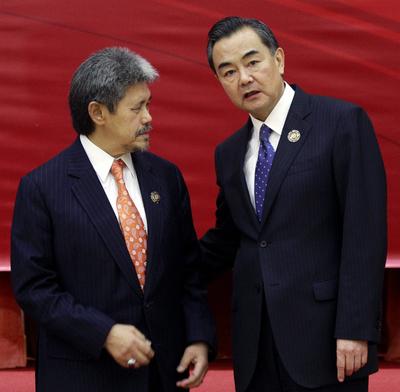What it needs to clarify is the extent, nature and basis of its maritime claims, which seem to cover most of the South China Sea’s waters. In 2009, China sent the UN Commission on the Limit of the Continental Shelf a map of the South China Sea with the infamous U-shaped line drawn; the map did not state whether that line demarcates a claim to the islands only or a claim to both islands and waters.
In response to growing regional tension and instability, it has been suggested by some scholars that China reassure its South China Sea neighbours and the world by issuing statements, considered below, with the aim of abating some of the tension without reducing the extent of its maritime claims.
First, China could argue that its claims are consistent with Article 57 of the UN Convention on the Law of the Sea (UNCLOS), which allows states to have an exclusive economic zone (EEZ) of up to 200 nautical miles. But in the presence of overlapping entitlements with the surrounding territories, the Paracels and Spratlys would not be allocated EEZs that extend the full 200 nautical miles nor to anywhere near the U-shaped line Beijing claims — an understanding reinforced by the International Court of Justice in Nicaragua v Colombia.
Second, China could assert that the U-shaped line dates back to 1947, conferring on China historical rights over the waters within that line which are not superseded by UNCLOS. But this statement is misleading. China has never actually declared that it claims all the waters within the U-shaped line, so no rights over those waters could ever have emanated from that line. If today China declares that it claims all these waters then it would be for the first time, and the earliest date for that claim would be today. The fact that the U-shaped line was drawn in 1947 does not mean the claim goes back to 1947.
Third, China could urge that the relevant parties to the disputes put aside the disputes and pursue joint development. Although this would be an ostensibly pragmatic way forward, it would also be unlikely to succeed. The reality is that China has made expansive claims to create arbitrary areas of overlapping claims; to then demand that other nations share resources within these areas with China would be very poorly received by other nations.
Finally, China could reassure its neighbours that it respects freedom of navigation in the South China Sea. This might be said to reassure the United States, which has a strong interest in keeping these sea lanes open. However, such a statement would be little more than rhetoric — affirming only that China respects freedom of navigation according to its own definition, which is different from that of the United States and the majority of countries.
Nations are reassured by the reasonable stance and behaviour of others, not rhetoric. Laying poorly clarified claims to most of the waters in the South China Sea, and attempting to coerce others to submit to these claims, is by no means reasonable. The only way China can reassure its neighbours is to bring its claims into conformity with UNCLOS and international law. China should be prepared to negotiate in good faith the limits of the disputed areas and, if this fails, settle its claim through an international court or tribunal.
Huy Duong contributes articles on the South China Sea to several news outlets including the BBC and Vietnam’s online publication VietNamNet.
A longer version of this article was first published here on Asia Sentinel.


I can definitely share this author’s point of view. Well written.
China did propose joint development in 2005
and reached an agreement with Vietnam and the
Philippines. It was the Philippines who rescinded the agreement in 2008 and acted unilaterally. Further China has consistently affirmed the freedom of navigation in the South China sea for merchant shipping. What they do object to is fishing near the disputed islands and the presence of other military shipping. What I find curious is why the same type of analysis is never made on the claims and actions of other nations involved. It seems to me that none of them come out smelling of roses.
“It was the Philippines who rescinded the agreement in 2008 and acted unilaterally.”
In fact the Philippines did not rescind the 2005 joint exploration agreement. That agreement expired in 2009 and the Philippines chose not to extend it.
“What they do object to is fishing near the disputed islands and the presence of other military shipping.”
In fact China “objects to” a lot more than that. Eg:
1) It objects to Vietnamese oil contracts in areas just off the coast of Vietnam and hundreds of miles away from the disputed islands. Furthermore parcelled out these areas and put them out for bidding.
2) It tries to claim historic fishing rights in Indonesia’s EEZ in the Natuna area, which is not anywhere near the disputed islands.